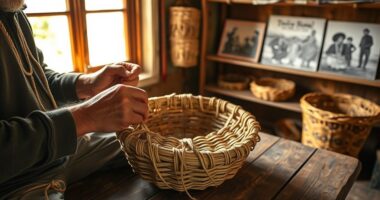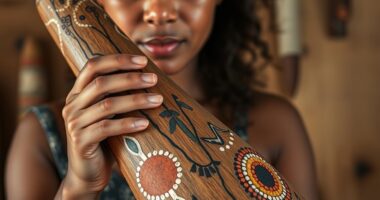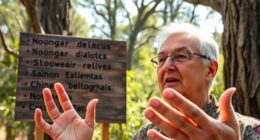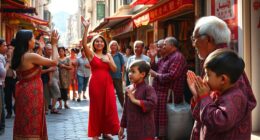Storytelling through songlines is a powerful way Indigenous communities map their land, history, and culture. You experience this when melodies act as living maps, guiding navigation and preserving stories across generations. These songs connect people to sacred sites, landmarks, and natural features, holding deep cultural meaning. As you explore further, you’ll discover how songlines serve as dynamic archives that keep traditions alive, ensuring that land, history, and identity stay intertwined.
Key Takeaways
- Songlines serve as living stories that map the land through melodies, connecting people with their environment and cultural history.
- They function as dynamic navigation tools, guiding Indigenous communities across landscapes via embedded stories and landmarks.
- Songlines preserve traditional knowledge, ensuring cultural practices, spiritual beliefs, and land connections are transmitted across generations.
- Singing or reciting songlines reinforces cultural identity, honoring ancestors and teaching younger generations about land and heritage.
- These stories symbolize a profound understanding of land, blending storytelling and geography to maintain cultural continuity and stewardship.

Songlines are more than just melodies; they’re living stories that connect people, land, and history. When you follow a songline, you’re tracing a path that has been passed down through generations, carrying the wisdom and memories of your ancestors. These songlines serve as essential tools for cultural preservation, guaranteeing that traditions, stories, and knowledge about the land are kept alive. They are not just songs; they are maps woven into sound, guiding you across vast landscapes while embedding cultural significance into every step.
Songlines are living maps that preserve culture, stories, and land through melody and memory.
Through these songlines, Indigenous navigation becomes a dynamic act of storytelling. You’re not simply moving from point A to B; you’re engaging in a practice that intertwines geography with history. Each verse, each refrain, marks a specific location or event, transforming the landscape into a living narrative. As you follow these paths, you learn to read the land in a way that words alone can’t convey. You come to understand the natural features, the waterholes, the sacred sites, and the seasons—all encoded within the melodies you carry in your mind and voice.
This method of navigation is deeply rooted in cultural preservation because it keeps traditional knowledge alive. You don’t need a map or compass; instead, you rely on your memory and the stories embedded in the songlines. This oral tradition guarantees that your community’s connection to the land remains strong, even as the physical landscape changes or new generations grow up. The songs serve as a living archive, passing down crucial survival skills, spiritual beliefs, and historical accounts that might otherwise be lost.
When you sing or recite a songline, you’re actively participating in a centuries-old practice that maintains your cultural identity. It’s a way to honor your ancestors’ guidance and to teach younger generations about their heritage and environment. This process reinforces a sense of belonging and responsibility to the land, emphasizing that your culture is deeply intertwined with the geography you traverse. Songlines do more than map the land; they map your identity, your history, and your future, guaranteeing that your people’s stories continue to resonate through time.
In essence, these songlines are living expressions of cultural preservation and Indigenous navigation. They’re a testament to a profound understanding of the land and a powerful way to keep that knowledge alive. As you follow these melodies, you participate in a tradition that sustains your culture, keeps your history vibrant, and connects you intimately with the land that has always been your home. Understanding traditional navigation techniques like songlines enriches our appreciation of Indigenous knowledge systems and their deep connection to the land.
Frequently Asked Questions
How Do Songlines Evolve Over Generations?
You see, songlines evolve over generations through oral tradition and cultural transmission. As each generation passes down stories and songs, they adapt to reflect new experiences or environmental changes. This continuous process allows the songlines to stay relevant, preserving cultural identity while integrating new insights. By actively sharing and maintaining these stories, you help keep the cultural significance alive, ensuring they resonate with future generations and remain an essential part of your community’s heritage.
What Specific Indigenous Groups Use Songlines Today?
You’ll find that Indigenous groups like the Aboriginal Australians, Yolngu, and Pintupi actively use songlines today to preserve their culture. They incorporate Indigenous languages into these songlines, ensuring linguistic and cultural preservation. By passing down stories through generations, they maintain their connection to the land and their heritage. These practices help keep their traditions alive, fostering cultural continuity and reinforcing their identity within their communities.
Can Songlines Be Mapped Digitally or Only Traditionally?
You can indeed map songlines digitally, blending tradition with modern technology. Digital mapping tools help you preserve culture by creating accessible, detailed representations of these oral stories. While traditional methods rely on memory and storytelling, digital approaches enhance cultural preservation, ensuring future generations can connect with their heritage. Embracing this fusion allows you to honor ancient pathways while making them more tangible and enduring in today’s digital world.
How Do Songlines Relate to Australian Aboriginal Spirituality?
You see, songlines are deeply connected to Australian Aboriginal spirituality through Dreamtime stories and ancestral pathways. They encode sacred knowledge about the land, creation, and spiritual beings, guiding your ancestors and ensuring cultural continuity. When you follow a songline, you’re tracing a spiritual map that links Dreamtime stories to specific landscapes, reinforcing the sacred relationship between land and spirituality, and maintaining cultural identity across generations.
Are Songlines Recognized Officially Within Australian Land Rights?
Yes, songlines are recognized officially within Australian land rights. Legal recognition acknowledges their importance in land management and cultural heritage. You should know that Indigenous groups often use songlines to assert their connection to the land, influencing legal decisions and land use planning. This recognition helps safeguard their cultural practices and ensures that their spiritual and cultural ties to the land are respected in legal and environmental contexts.
Conclusion
As you follow the songlines across the land, remember you’re tracing the footsteps of ancestors, weaving their stories into your own journey. Like the river that never ceases to flow, these melodies carry the heartbeat of a culture, echoing through time. With every step, you become part of a sacred tapestry—where land and story intertwine—reminding you that, like the eternal song, the spirit of storytelling endures forever, guiding us home.
Mary is a passionate writer who brings creativity and a fresh perspective to our team. Her words have the power to captivate and inspire, making her an essential contributor to our content. Mary’s commitment to storytelling and dedication to promoting Indigenous culture ensures that her work touches the hearts of our readers. We’re fortunate to have her as part of our team.










